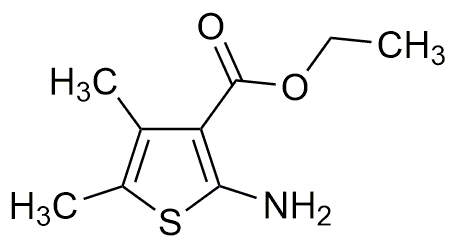Ethyl 2-amino-4,5-dimethylthiophene-3-carboxylate is widely utilized in research focused on:
- Pharmaceutical Development: This compound serves as an important intermediate in the synthesis of various pharmaceuticals, particularly those targeting neurological disorders, due to its unique thiophene structure that enhances bioactivity.
- Agrochemical Formulations: It is used in the formulation of agrochemicals, providing effective solutions for pest control by acting as a bioactive agent that can improve crop resilience.
- Material Science: The compound is explored in the development of advanced materials, such as conductive polymers, which are essential in electronics and renewable energy applications.
- Biochemical Research: Researchers utilize it to study enzyme interactions and metabolic pathways, aiding in the understanding of biological processes and disease mechanisms.
- Analytical Chemistry: It is employed as a standard in analytical methods, helping to improve the accuracy and reliability of chemical analyses in various laboratories.
General Information
Properties
Safety and Regulations
Applications
Ethyl 2-amino-4,5-dimethylthiophene-3-carboxylate is widely utilized in research focused on:
- Pharmaceutical Development: This compound serves as an important intermediate in the synthesis of various pharmaceuticals, particularly those targeting neurological disorders, due to its unique thiophene structure that enhances bioactivity.
- Agrochemical Formulations: It is used in the formulation of agrochemicals, providing effective solutions for pest control by acting as a bioactive agent that can improve crop resilience.
- Material Science: The compound is explored in the development of advanced materials, such as conductive polymers, which are essential in electronics and renewable energy applications.
- Biochemical Research: Researchers utilize it to study enzyme interactions and metabolic pathways, aiding in the understanding of biological processes and disease mechanisms.
- Analytical Chemistry: It is employed as a standard in analytical methods, helping to improve the accuracy and reliability of chemical analyses in various laboratories.
Documents
Safety Data Sheets (SDS)
The SDS provides comprehensive safety information on handling, storage, and disposal of the product.
Product Specification (PS)
The PS provides a comprehensive breakdown of the product’s properties, including chemical composition, physical state, purity, and storage requirements. It also details acceptable quality ranges and the product's intended applications.
Certificates of Analysis (COA)
Search for Certificates of Analysis (COA) by entering the products Lot Number. Lot and Batch Numbers can be found on a product’s label following the words ‘Lot’ or ‘Batch’.
*Catalog Number
*Lot Number
Certificates Of Origin (COO)
This COO confirms the country where the product was manufactured, and also details the materials and components used in it and whether it is derived from natural, synthetic, or other specific sources. This certificate may be required for customs, trade, and regulatory compliance.
*Catalog Number
*Lot Number
Safety Data Sheets (SDS)
The SDS provides comprehensive safety information on handling, storage, and disposal of the product.
DownloadProduct Specification (PS)
The PS provides a comprehensive breakdown of the product’s properties, including chemical composition, physical state, purity, and storage requirements. It also details acceptable quality ranges and the product's intended applications.
DownloadCertificates of Analysis (COA)
Search for Certificates of Analysis (COA) by entering the products Lot Number. Lot and Batch Numbers can be found on a product’s label following the words ‘Lot’ or ‘Batch’.
*Catalog Number
*Lot Number
Certificates Of Origin (COO)
This COO confirms the country where the product was manufactured, and also details the materials and components used in it and whether it is derived from natural, synthetic, or other specific sources. This certificate may be required for customs, trade, and regulatory compliance.


